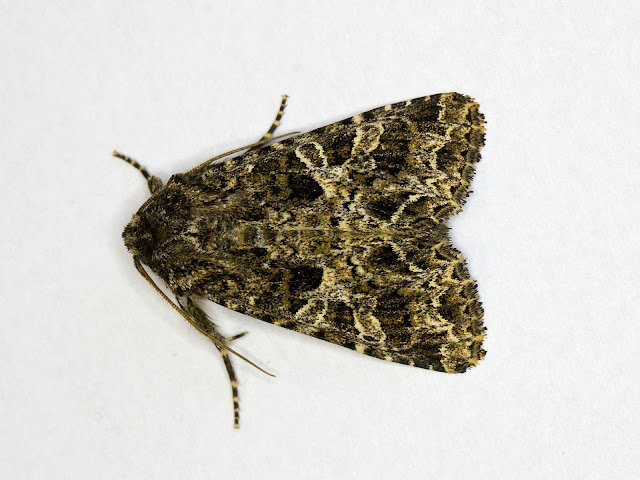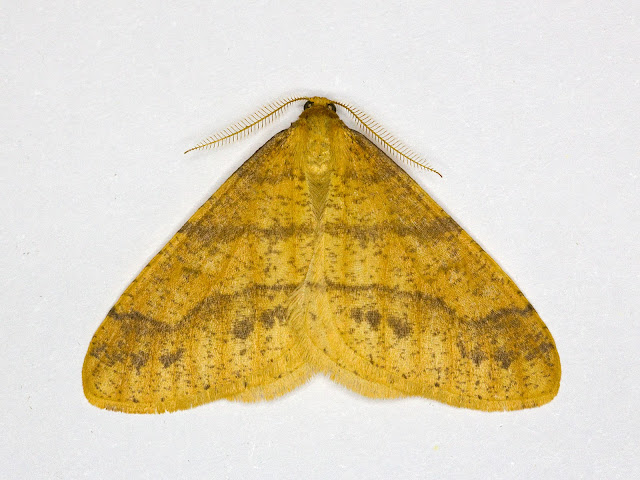The moth trap is still proving to be an interesting distraction in these times of covid-19. With a small urban garden, close to the sea and a couple of miles from the nearest countryside, I hadn't really expected to see too much in the way of numbers and variety in the trap. I have to say I have been pleasantly surprised. True, the numbers are not huge, probably a maximum of forty to fifty a night, but as a beginner the challenge of identification has been enough to keep me occupied for a good few hours each time the trap is run.
The following is just a selection of some of the moths caught. There is nothing special about them, I just feel the need to keep an occasional record on the blog. Google permitting I will be able to return to and read them again in future years.
My first moth is a Blair's Mocha. Previously an occasional migrant species but now resident on the south coast. Just a fascinating shape particularly with the appearance of a streamlined head. One of the benefits of global warming and of living on the south coast is that we get to see these species before the rest of the country.
 |
| Blair's Mocha - Cyclophora albipunctata |
The picture was taken in the lid of the sample pot as I have found these Geometridae difficult to photograph. Sure enough, when I tried to transfer it to a better background it took the opportunity to escape. I may not be an expert on handling moths but one thing I learnt from birding is get your record shot first then worry about getting a good picture.
The next moth, a Blood Vein, required me to use a different set of skills, those of butterflying and in particular the pursuit of the Pearl-bordered species. I disturbed this one whilst walking along the North Wall at Pagham and watched as it disappeared into the distance. There then followed a half hour search and pursuit, during which it regularly disappeared form sight and often settled in spots where it couldn't be photographed, but eventually I got the picture.
 |
| Blood-vein - Timandra comae |
One from the trap, a Campion. Nice looking moth and easy to identify as it is reasonably fresh and still shows the purplish marbling on the wings. The picture below that is of the very similar looking Lychnis. When the Campion is older and faded they are harder to tell apart. You are then comparing the width of the wing, the kidney and eye shapes on the Campion being more distorted, and the shape of the outer white cross line on the forewing. More subjective and not easy unless you have the two side by side.
 |
| Campion - Hadena rivularis |
 |
| Lychnis - Hadena bicruris |
And now for something completely different, a Chinese Character. This species holds its wings erect when at rest and resembles bird droppings. The camouflage seems to work with birds reported to often ignore it when feeding. At only 10-13mm long and looking like something you don't want to put your hand on this moth is easily overlooked.
 |
| Chinese Character - Cilix glaucata |
There are a number of Noctuid moths called ‘Wainscots’. The name refers to their colour and pattern rather than suggesting closer family links. They are generally off-white with veins giving the appearance of longitudinal whitish stripes all the way down the forewing. Below are two of these, the Common and the L-album.
 |
| Common Wainscot - Mythimna pallens |
 |
| L-album Wainscot - Mythimna l-album |
Most moths rest with their wings flat or curled up close to their bodies. There are, however, a few examples of moths that will rest with their wings held aloft like a butterfly. Below is a Cypress Carpet showing this behaviour, with the picture after that the same moth with its wings flat.
 |
| Cypress Carpet - Thera cupressata |
 |
| Cypress Carpet - Thera cupressata |
And below a Latticed Heath holding a similar position. This moth was in the kitchen for most of the day and seemed to hold the vertical wing position for all of that time.
 |
| Latticed Heath - Chiasmia clathrata clathrata |
A Delicate, not rare but the first one I have seen and below that a Pale Mottled Willow. The latter being easy to identify from the white spots around the kidney mark.
 |
| Delicate - Mythimna vitelina |
 |
Pale Mottled Willow - Paradrina clavipalpis
|
Another Geometridae, the Light Emerald. It is said to be common but I have only ever seen one of them, this on a leaf at the side of the trap. I nearly missed it but I have now got into the habit of searching all the vegetation close to the trap.
 |
| Light Emerald - Campaea margaritata |
The Orange Swift is part of the Hepialidae family. These are primitive moths that have no working proboscis or mouth parts, so only live about a week. There are around 500 species worldwide with just five occurring in the British Isles.
 |
| Orange Swift - Hepialus sylvina |
Underwings have been plentiful in the trap of late. They are mostly varieties of the Yellow underwings and strangely most are in very poor shape. Rather than show those, here are two in better condition, a Copper Underwing which unfortunately I could not get to open its wings and a Red Underwing which was more obliging but only when sitting on the Red Blinds. I think the identification as Copper Underwing rather than Svensson's Copper Underwing is correct but I can't be sure hence the Amphipyra agg designation.
 |
| Copper Underwing agg - Amphipyra agg |
 |
| Red Underwing - Catocala nupta |
I haven't yet found a reliable method of getting the moths to display the underwing. Perhaps its pure luck......
and below a Setaceous Hebrew Character included because it was showing some of the underwing. It makes such a difference to the pictures.
 |
| Setaceous Hebrew Character - Xestia c-nigrum |
I have included a picture of the Rush Veneer as a representative of the Micro Moths although at 12-15mm it is actually bigger than many of the Macros.
 |
| Rush Veneer - Nomophila noctuella |
I include the next two pictures because the use of camouflage by moths is fascinating. I understand that thousands of years of natural selection will have developed wing colours and patterns that match their natural habitat. However, there seems to be more at play here.
I placed the Treble-bar below on a stone wall where it stayed for about twenty seconds before relocating to an adjacent wooden panel. It then proceeded to move around in what appeared to be an attempt to line up its wing markings with the woodgrain. Unfortunately in my attempts to get a picture I flushed it so never got to see the final result.
 |
| Treble-bar - Aplocera plagiataplagiata |
The Willow Beauty was another example. I placed it on a piece of plain wall and it quickly relocated to this textured area.The match is so good it looks as though the moths wings are transparent. Does this show a level of self-awareness, of the moth knowing what it looks like, or is it just coincidence. I am not sure but it is something I will be looking for in the future.
 |
| Willow Beauty - Peribatodes rhomboidaria |
So much more to see and wonder at. Why didn't I start looking at moths years ago?





























































